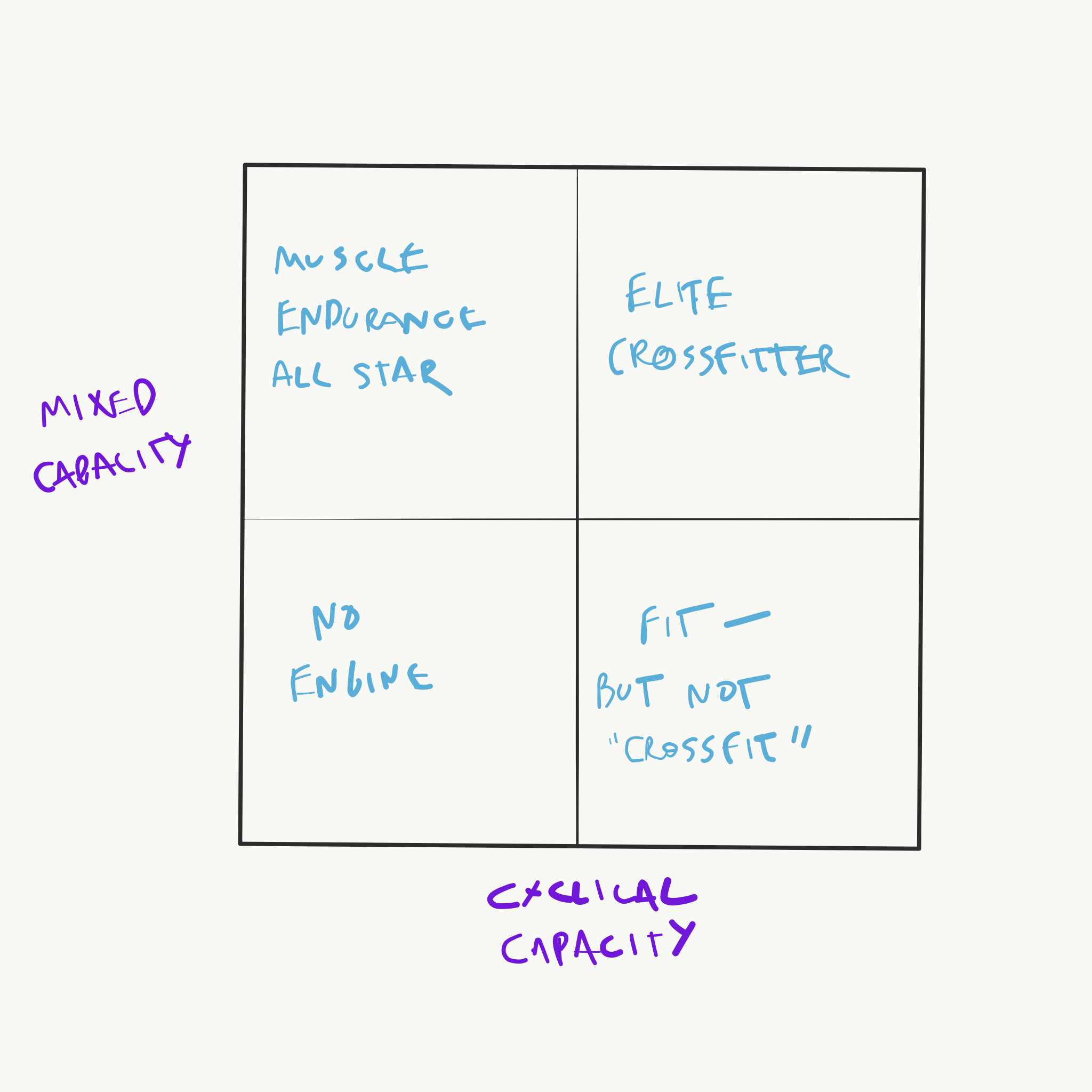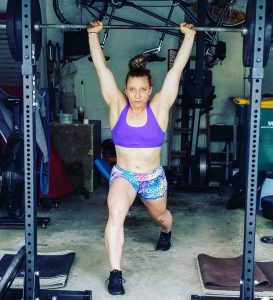After a long, tough workout, athletes often end up on their backs thinking something like, “I really need to improve my engine.”
Whether it’s an open workout like 19.1 with 15 minutes of rowing and wall balls, a 2000m row time trial, or a spicy 10 minute AMRAP of thrusters, double-unders, and box jumps, athletes often end up hunched over with their hands on their knees huffing and puffing.
But, it’s not as simple as doing more longer workouts, more tough ten minute AMRAPs, or more rowing and biking intervals.
Building an engine in a complicated mixed modal environment requires some assessment and some planning since there’s a lot of different traits and capacities that can result in athletes either thriving or struggling in conditioning workouts.
Some athletes are great across the board and seem to do well in anything that involves working out for more than a few minutes while being out of breath.
Others are fantastic at cyclical conditioning pieces like rowing, biking and running, but struggle to put it together when they have to do multiple different movements in a session.
Others are great at high turnover pieces made up of things like light dumbbell snatches and burpee box jump overs, but seem to fall apart when they have to do something more difficult and grindy like a heavy deadlift or sandbag over shoulder.
We can get fooled by looking at the best of the best, since they seem to be able to do any and every type of workout with success, and they often credit their engine to the work they put in on the erg or the assault bike, or they claim that they just do difficult “CrossFit workouts” to improve their conditioning.
While they may be correct in describing their own training, it’s often much more complicated for folks who aren’t quite as adaptable and who may have significant weak points despite doing well on some types of conditioning work.
So, how should we think about “building an engine” for a CrossFit athlete?
We should start with an assessment to figure out what we need to work on.
Then, based upon that, we can start to train in order to build an aerobic base, make different kinds of skills more sustainable in a fatigued environment, then put it all together when we are going to be tested.
Testing Pieces to Understand where your Conditioning Needs Work
Getting an idea of where you sit in a variety of different conditioning tests with different characteristics is crucial to developing a plan to improve.
As I’ve become more experienced, I’ve become less and less enamored with the exact specifics of testing data since I think the tests are noisy and they tend to stress athletes out, but having an idea of what kinds of workouts you do well on and what kinds of workouts you struggle on is a necessary starting point.
Here’s a few different types of tests on which we have a lot of data points, which enables some comparison between athletes.
It’s important to have a general idea of where you sit on a variety of cyclical benchmarks – although, past a certain point, improving cyclical numbers often doesn’t result in improvement in mixed testing.
We can also consider the relative pace that you’re able to hold for shorter timeframes versus longer timeframes.
Everyone will obviously have some level of drop-off in testing as the timeframe or distance increases, but there is a clearly a spectrum in terms of athletes who have similar paces for all timeframes (and often struggle to achieve very high power outputs) and athletes who have a larger drop-off as the timeframe is extended (and who often struggle with more endurance-based activities).
As you may have guessed, it’s usually better to be in the “same pace” camp for CrossFitters.
Cyclical Benchmarks
500m row
•Elite Scores:
Male: Under 1:24
Female: Under 1:30
•Advanced Scores:
Male: Under 1:30
Female: Under 1:40
2000m row
•Elite Scores:
Male: Under 6:45
Female: Under 7:00
•Advanced Scores:
Male: Under 7:00
Female: Under 7:30
5000m row
•Elite Scores:
Male: Under 18:30
Female: Under 20:00
•Advanced Scores:
Male: Under 20:00
Female: Under 22:00
60 min row
•Elite Scores:
Male: Over 15,600 meters
Female: Over 14,400 meters
•Advanced Scores:
Male: Over 15,000 meters
Female: Over 13,800 meters
10 min AMRAP assault bike calories
•Elite Scores:
Male: Over 200 calories
Female: Over 150 calories
•Advanced Scores:
Male: Over 180 calories
Female: Over 130 calories
30 min AMRAP assault bike calories
•Elite Scores:
Male: Over 500 calories
Female: Over 400 calories
•Advanced Scores:
Male: Over 450 calories
Female: Over 360 calories
1 mile run
•Elite Scores:
Under 5:30
•Advanced Scores:
Under 6:00
3000m run
•Elite Scores:
Under 12:00
•Advanced Scores:
Under 13:30
High Turnover Mixed Pieces
“19.1″
15 min AMRAP:
19 row calories
19 wall balls
•The combination of a cyclical activity with a moderate sized set of wall balls shows what kind of pace and cycle times athletes can maintain without running into situations where they are having to take big rests between sets. Plus, there’s a lot of data points on this test to compare against.
•Elite Scores:
Male: Over 9.5 rounds
Female: Over 8.5 rounds
•Advanced Scores:
Male: Over 8.5 rounds
Female: Over 7.5 rounds
10 rounds for time:
4 burpees
6 wall balls
8 KB swings (70/53)
•Differences in capacity on this tend to come down to cycle time and transition time, especially since the sets are small enough that most athletes should not be running into significant muscle endurance limitations.
•Elite Scores:
Under 8:30
•Advanced Scores:
Under 10:00
For time:
75 DB snatches, alternating (50/35)
75 burpee box jump overs (24/20)
75 DB snatches, alternating (50/35)
•By restructuring 17.1 into more of a “chipper,” we can get a feel for how athletes respond to large sets of single movements. We find that some athletes struggle much more when they have to do the same movement over and over – as opposed to be being able to switch back and forth between different activities. Most people will be slower on this than they will be on 17.1, but we can still benchmark relative to the total time it takes them to complete 150 dumbbell snatches and 75 burpee box jump overs.
•Elite Scores:
Under 12:00
•Advanced Scores:
Under 14:00
Longer Piece with Long Stretches of One Movement
For time:
2000m row
500 double-unders
3 mile assault bike
•This tests not just sustainable pace in a cyclical modality, but whether you are able to get through a big chunk of a high skill movement under fatigue. Some folks will do well in purely cyclical tests, but lose coordination and muscle endurance capacity once they’ve accumulated nearly any amount of fatigue.
•Elite Scores:
Male: Under 23 minutes
Female: Under 25 minutes
•Advanced Scores:
Male: Under 25 minutes
Female: Under 28 minutes
Long, Grindy Mixed Work
40 double DB front squats (50/hand – 35/hand)
3 miles assault bike
40 double DB box step-overs (50/hand to 24″ – 35/hand to 20″)
2 miles assault bike
20 double DB front squats (50/hand – 35/hand)
1 mile assault bike
20 double DB box step-overs (50/hand to 24″ – 35/hand to 20″)
•The cycle time on double DB front squats and double DB box step overs tends to be fairly slow – especially when approaching big sets of each movement. This is a test of the ability to “grind” at a steady pace rather than to move quickly and switch back and forth between different exercises.
•Elite & Advanced Scores
Need more data!
“Regionals 18.5″
For time:
50 handstand push-ups
50 toes-to-bar
50 assault bike calories
50 DB box step-overs (70/hand to 24″ – 50/hand to 20″)
50’ front rack + overhead DB lunge, right (70/hand – 50/hand)
50’ front rack + overhead DB lunge, left (70/hand – 50/hand)
•Elite
Under 17 minutes
•Advanced
Under 22 minutes
Long, high turnover
5 rounds for time:
1000m row
15 pull-ups
15 thrusters (75/55)
15 burpees
•Elite Scores:
Male: Under 30 minutes
Female: Under 35 minutes
•Advanced Scores:
Male: Under 35 minutes
Female: Under 40 minutes
20 min AMRAP:
16/12 row calories
8 bar-facing burpees
•Elite Scores:
14+ rounds
•Advanced Scores:
12-13 rounds
20 minute AMRAP
11 kettlebell swings (53/35)
11 box jumps, step down (24″/20″)
200m run
11 burpees
11 wall balls (20 to 10’/14 to 9′)
•Elite Scores:
6+ rounds
•Advanced Scores:
12-13 rounds
5+ rounds
Simple Work/Rest Scenarios
EMOM 30:
1st: 15 row calories
2nd: 15 burpees
•We can benchmark this as a simple “can you complete this amount of work in the allotted time” tester – and we can also compare relative paces throughout. Forced work and rest scenarios like this can show that some folks are able to recover from “hard work” very quickly in just a few seconds, and are seemingly able to recharge and keep going indefinitely while others dig deeper and deeper as they go on something like this.
•Elite Scores:
Male: Complete the work with sustainable effort throughout
Female: Complete the work
•Advanced Scores:
Male: Complete the work but slow down and suffer throughout
Female: Complete the work with 12 row calories
“Death by…”
1st: 1 burpee + AMRAP rowing meters in remaining time
2nd: 2 burpees + AMRAP rowing meters in remaining time
3rd: 3 burpees + AMRAP rowing meters in remaining time
…
Continue until failure to complete burpees in allotted time.
•Record both burpees completed and meters rowed.
•This is both a test of capacity and of strategy. You want to maximize the amount of burpees that you’re able to get since that also maximizes the opportunity that you have to row for meters. But, if you push too hard on the rowing in order to get more meters in, the burpees can very quickly fall apart.
What type of athlete are you?
Based upon where you sit on a handful of these tests, you can ideally put yourself into a bucket in terms of your “mixed capacity” (meaning your ability on workouts that involve multiple different modalities) and your “cyclical capacity” (meaning your ability on tests that only involve running, biking, rowing, etc.)

Bucket #1: Lacking Capacity in General
In this bucket, your cyclical benchmarks, your mixed benchmarks, your long benchmarks and your short benchmarks are all lacking relative to the level that you would like to compete at.
This is often the case for folks who are relative beginners and need to spend more time training to build their capacity – as well as for people who tend to be “strength and power” athletes who struggle with any sort of sustainable activity.
Bucket #2: Good in Cyclical Capacity, Lacking in Mixed Capacity
This bucket is often the most complicated bucket to be in – and where most “pretty good” competitors will fall. This requires some more analysis to figure out what’s going on, since all kinds of different movements and movement combinations can cause confusing and complicated fatigue scenarios for different individuals.
People in this bucket often struggle more with “muscle endurance” than they do with capacity.
So, they need to learn to do muscle endurance activities in a sustainable way.
Athletes in this bucket will often find that certain combinations of movements allow them to perform very well, but other combinations or styles of workouts result in them locking up, falling apart, and struggling to maintain their pace.
In order to improve the sustainability of mixed work for these individuals, they need to start in scenarios in which they are able to maintain their paces without “blowing up” or “having their shoulders lock up,” etc.
Then, from there, they need to progress the difficulty and the messiness of the scenarios in which they are able to sustain mixed work.
For example, an athlete in this bucket may be able to do something like the below with consistent paces and good recovery:
5 rounds @ 85-90% effort:
15 assault bike calories
12 chest-to-bar pull-ups
9 kipping handstand push-ups
-Rest 2 min
However, they might fall apart when asked to do something like this:
10 min AMRAP:
3-6-9-12…chest-to-bar pull-ups
3-6-9-12…thrusters (115)
3-6-9-12…assault bike calories
This athlete needs to progress their ability to do muscle endurance activities into more complicated and chaotic scenarios where there is potentially significant interference between movements and more accumulated fatigue.
We will cover more ideas surrounding training progression in the next part in this series.
Bucket #3: Good in Mixed Capacity, Lacking in Cyclical Capacity
This is the bucket for someone who is often much better at “CrossFit” than it seems like they should be based upon their scores in cyclical tests.
This bucket also often creates confusion for people who look at the scores at the CrossFit Games or Sanctionals and see some pretty terrible output from folks on things like rowing, running and biking.
These people are often muscle endurance all stars – meaning that they are able to do a lot of different types of contractions in a lot of different scenarios without hitting muscle endurance fatigue. And, when they do hit muscle endurance fatigue, they are often able to take a quick break and get right back to work.
When these people compete in an event that isn’t limited by muscle endurance for most people or that requires steady, consistent output in a cyclical modality, they can struggle a surprising amount compared to their performance in more classic “CrossFit” style pieces.
Sometimes, this is partially-based upon limb length and body size.
A 5’7″ male with super short arms and legs may be fantastic on squatting and burpees based upon his range of motion, but will potentially struggle to get enough leverage and torque on things like the erg and the Assault Bike.
Still, over athletes thrive in muscle endurance-based scenarios, but struggle to maintain steady output. They are good at switching between exercises or “chipping away” at large sets, but are not as good at moving consistently in a cyclical environment.
There are likely differences in terms of how the body creates and utilizes energy and oxygen in steady movement scenarios vs mixed scenarios, so these folks can often benefit from focusing on improving their pacing and their capacity in cyclical modalities.
That said, they can often “get away” with relatively poor cyclical capacity based upon the structure of most tests. If they are trying to win a Sanctioned Event, they will probably need to improve in long, single modality tests since those are often part of the programming menu. However, if they are just looking to do reasonably well in the Open and do some local competitions, they are rarely going to be tested in something like a long run, a long row or a long swim.
Bucket #4: Good in Both Mixed and Cyclical Capacity
These folks are usually the elite and are often good at everything.
The training for these people can often involve a lot of different stuff thrown together, since they are able to perform well and adapt to almost any scenario.
They can do a bunch of different “metcons” and pace appropriately and complete all the work without gassing out.
They can throw in additional rowing and running intervals several times per week because they have significant capacity in these modalities and are able to adapt to the additional training.
Copying the training of these kinds of athletes if you are not one of them can lead to some pretty messy outcomes, since – if you are not able to pace appropriately and make all kinds of different training scenarios sustainable – you may end up running yourself into the ground with training.
Just because these folks are seemingly “good at everything,” it doesn’t mean that they don’t have some specific movement patterns or combinations of movements that they struggle with.
Based upon this, they will also need to work on making those things that they struggle with sustainable across a broad variety of scenarios. They will just have more leeway in terms of the type of training that they can do to stimulate progress.
The next article in this series will dig into some more specific ideas for training each type of athlete.





3 Responses
Hi Todd,
Putting this much information out here for all of us lost souls trying to build our fitness is truly priceless. I can’t thank you enough for spending so much time on this and then giving it out for free.
Frank
Thanks, Frank. Hopefully it’s actually helpful and there were some tangible takeaways.